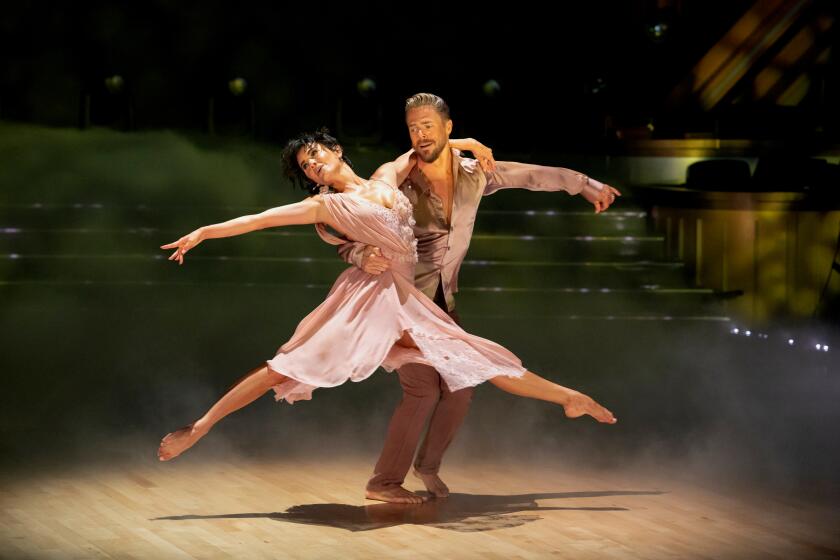We the People, in Order to Form More Perfect Art : Exhibit: Taking democracy to a logical extension, âPolling of Americaâ reveals the tastes of a majority that doesnât usually rule.
If democracyâs so great for society at large, why shouldnât it work for the art world?
A preposterous question, perhaps, but one that Russian emigre artists Vitaly Komar and Alexander Melamid ponder with their tongue-in-cheek installation, âKomar & Melamid: Peopleâs Choice: The Polling of America,â now at the Huntington Beach Art Center.
Arriving in the United States in 1978, the longtime collaborators âdiscovered that America is a much better and more comfortable place to live than the Soviet Union,â Melamid said recently, âand that [democracy] is better than any other system we know about.â
Conversely, they found that the Western art world runs on a âmedieval idea of aristocracy,â Melamid said, in which a small group of gallery owners, curators and artists, ostensibly superior by âgenetics or education,â decides whatâs good or bad, marketable or passe.
Clearly, thatâs not majority rules. So the artists commissioned a poll to determine what Americans most want in their art.
âIf the Democratic system is so good and based on the idea of the majority making decisions,â Melamid said with more than a touch of irony, âthen maybe the same idea applied to other spheres of human activity will make them work better as well.â
They enlisted the Boston-based research firm Marttila & Kiley to poll 1,001 people. What color do most Americans prefer? Blue. Do they favor tame or wild animals? Wild. Outdoor or indoor scenes? Outdoor. Traditional or modern art? Traditional. Famous or anonymous people? The people like both.
Armed with this information, Komar and Melamid created âAmericaâs Most Wanted,â a bucolic, 19th-Century-style landscape dominated by a big blue sky and blue lake (Melamid calls it a blue landscape). Itâs populated by George Washington, three unknown people, a hippopotamus and two deer.
The traveling exhibit also illustrates the pollâs hard data with colorful pie charts and bar graphs, some in sculptural, three-dimensional form, and contains âAmericaâs Most Unwanted,â a small geometric abstract.
Komar, 52, and Melamid, 50, are well known for work that satirizes the former Soviet Unionâs creatively stifling, state-enforced Socialist Realism.
*
During a phone interview from his New York studio, Melamid wouldnât come right out and say whether âMost Wantedâ proves or disproves that a democratic process produces good art. His response, however, like the wretched landscape, made the answer clear.
âA majority of Americans told what they wanted. Maybe no one in particular likes it, but the majority likes it.â
But donât polls lie?
âRegardless of what you think of polls,â he said, âthey are the only tool in our democratic society, and in any society, to communicate with the people and find out what the people want and to [enable] communication between the higher and lower classes. So if this is not democracy, what is?â
Indeed, he pointed out, the idea of statistical determination harks back to democracyâs forefathers, the ancient Greeks.
âThey worshiped numbers in a way, and in order to make a sculpture of the ideal human body, they measured the most beautiful people of their time and made an approximation. So all these beautiful Venuses are based on some statistical data. Numbers are pure, beautiful, and maybe itâs idealistic, but if thereâs any truth, I think itâs in numbers and statistical approximation.â
*
Surely the creative process is more subjective than that, isnât it?
âItâs not true,â Melamid said, âand where did you get that idea? Who wrote that? Who put forward this idea of subjectivity of art? Is the source known? Was it given by God, written in the Bible? Many people tell me this, but I never get an answer.â
âPeopleâs Choice,â organized by New Yorkâs Alternative Museum, also contains âRussiaâs Most Wanted.â That lakeside landscape is similar to Americaâs favorite painting with the added elements of Jesus Christ, children and a bear.
Next year, the artists plan to exhibit in Cologne, Germany, most wanted and most unwanted paintings from at least 15 other countries including Kenya, China, Finland and Turkey.
By the year 2001, they hope to have combined these countriesâ preferences for the worldâs most wanted. It might look familiar, Melamid said.
âMost of the people,â he said, âlike blue landscapes, period.â
* âKomar & Melamid: The Peopleâs Choice: The Polling of Americaâ continues through Nov. 12 at the Huntington Beach Art Center, 538 Main St., Huntington Beach. Hours are Tuesday through Thursday, noon to 8 p.m.; Friday and Saturday, noon to 9 p.m.; Sunday, noon to 4 p.m. Admission is $3, students and seniors $2. (714) 374-1650.
More to Read
The biggest entertainment stories
Get our big stories about Hollywood, film, television, music, arts, culture and more right in your inbox as soon as they publish.
You may occasionally receive promotional content from the Los Angeles Times.










